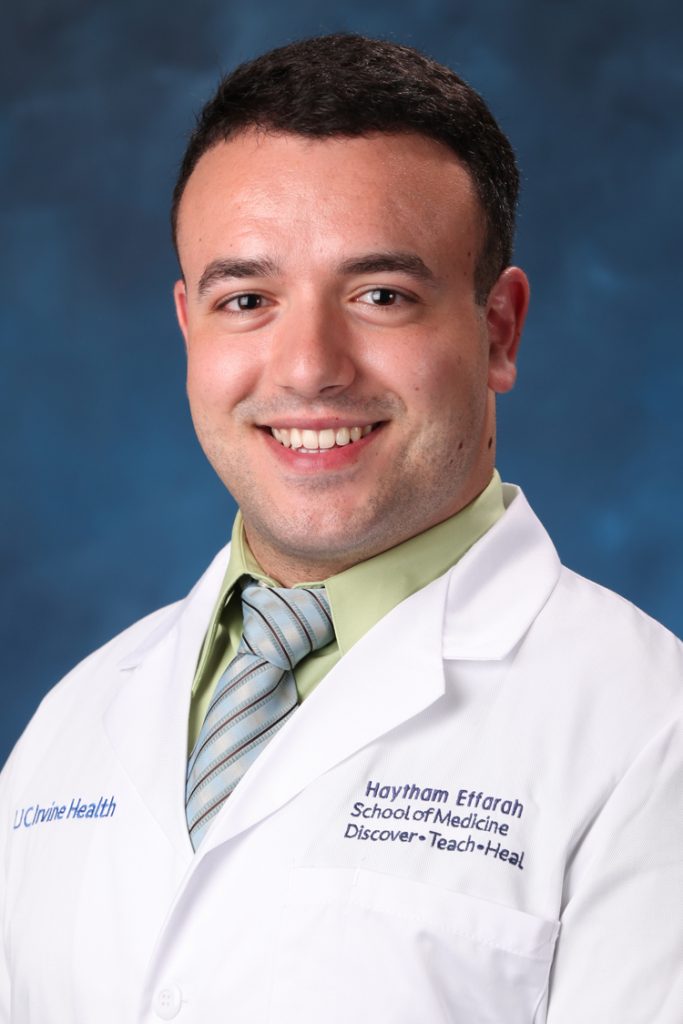Haytham Effarah is a first-year graduate student who is completing the MD/PhD Medical Scientist Training Program at UC Irvine. He has finished the first two years of medical school, the didactic phase, and after finishing his PhD he will return to medical school to finish the last two years for the clinical phase. The Medical Scientist Training Program (MSTP) is an NIH-funded doctoral training program that’s currently awarded to 50 institutions in the United States. MSTP institutions (like UC Irvine) are given federal support to train students as both medical doctors and researchers through obtaining both MD and PhD degrees. The typical program length is approximately 8 years, but there’s some flexibility depending on which PhD you pursue. Most MSTP students will obtain PhDs in the School of Medicine (like neurobiology, physiology, etc.), but the UC Irvine MSTP and the UCI Physics Department were very open-minded and accommodating to Haytham’s goal of pursuing a PhD in physics. Notably, it has been over 15 years since someone in the UC Irvine MSTP has pursued a PhD in physics. Haytham says the ultimate mission of the MSTP, in brief, is to bridge the gap between academia and medicine, and he feels best suited for this mission right here in the physics department.
Trying to straddle the interface between physics and medicine can be tricky and often overwhelming, but Haytham says he finds it to be as rewarding as it is challenging. One of his biggest research interests since undergraduate studies has been developing and implementing medical diagnostic techniques. Half the battle in medicine is being able to accurately identify what is wrong with a patient, and he feels that being a part of making that process easier and more efficient is a worthy calling. Haytham is currently working under Prof. Chris PJ Barty, the senior faculty hire for the Convergence in Optical Sciences Initiative (COSI). The group studies the generation of monochromatic x-rays through Compton scattering and the medical applications of those x-rays. Monochromatic x-rays can be utilized to produce high resolution 3D images of living tissues while imparting lower radiation doses than conventional x-ray beams. With higher resolution imaging they can more accurately identify problems like tumors or cysts; and by lowering the radiation dose they can do diagnostic imaging with less risk to patients. Haytham says there are also applications for using high-energy monochromatic x-rays for targeted cancer therapy, which adds another dimension of research possibilities!
His first experience with doing research in a physics department was when he came to UC Irvine. Most of his research experience before graduate school has been in organic chemistry. Haytham was originally enrolled at UC Davis as a neurobiology, physiology, and behavior major before eventually switching to physics. He started working in a National Primate Lab, studying how rhesus macaques expressed emotion. He then won the Beckman Scholar Award and was funded to pursue an independent research project in organic chemistry. Haytham says he was inspired to apply for the award after finding a mentor in Dr. Annaliese Franz (also a graduate student from UC Irvine). After that his interests shifted; the Franz Group at UC Davis really got him excited about diagnostic technologies, and when he was applying to MD/PhD programs, he was enamored with the Beckman Laser Institute at UC Irvine. Haytham says the interface between the physical sciences, engineering, and medicine was exactly what he was looking for.
As Haytham progresses through his PhD, he hopes to have experience working with ultrafast lasers, Compton scattering, x-ray/tissue interactions, and medical applications of monochromatic x-rays. He wants to figure out where his interests predominantly lie, and where amongst those topics his thesis will exist. After he gets his PhD, he says he is going to breathe a satisfying sigh of relief, and then get right back to medical school. Haytham aims to use the great critical thinking skills he will have developed and put them to use in the hospital setting. After medical school he plans to spend at least four years in a residency program; before looking for a faculty position at a research university. Haytham says he wants to see patients and do translational research as part of his long-term career, but is unsure about what exactly that will look like. He says there are a lot of ways that MD/PhD graduates apportion their time, and he will probably have a better idea of how he wants to apportion his after he decides on a medical specialty and finishes his residency.
Outside of work, Haytham loves playing video games, board games, and Dungeons and Dragons. He has developed an interest in sailing since moving to Irvine and loves to go camping (especially backpacking) when an opportune weekend presents itself. He also has an appreciation for classic fiction and sci-fi literature, and he has been to the San Diego Comic Con for eight years in a row. Haytham says scheduling in time for fun can sound weird but is usually the most effective way to ensure that he doesn’t spend all of his time working or distracting himself with memes when he’s tired of working. He tries to make these plans with others, as he feels it’s harder to break a commitment to a friend than to himself. Haytham also firmly believes in finding mentors and colleagues that are fun to be around. While academia has its ups, it has plenty of downs; and he’s found that it’s much easier to get through those downs when he’s surrounded by people who he enjoys and who support him.
The Student Spotlights are a series brought to you by a collaboration between the UCI Physics and Astronomy Blog Team and the Physics Graduate Caucus at UCI


